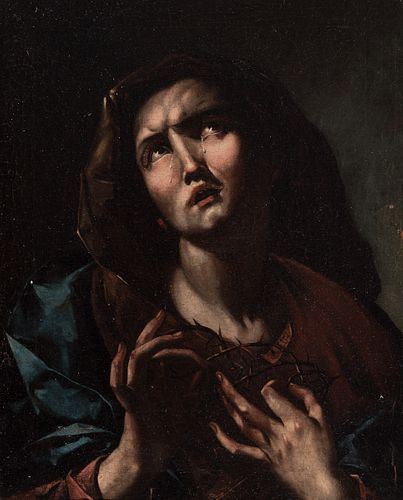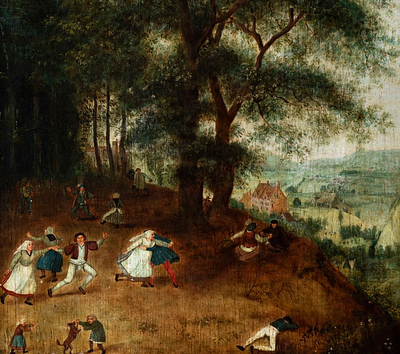Neapolitan school; 18th century. "Madonna dei Dolori". Oil on canvas. It keeps its original fabric. Presents a carved wooden frame from the 18th centu
Lot 94
About Seller
Setdart Auction House
Carrer Aragó 346
Barcelona
Spain
Setdart Subastas was born in 2004 and is currently the first online art auction in Spain with solidity, prestige and reliability guaranteed by our more than 60,000 users. Setdart has a young, dynamic and enterprising team ready to successfully manage the purchase and sale of art works through custom...Read more
Estimate:
EUR€6,000 - EUR€9,000
$6,250 - $9,375
Absentee vs Live bid
Two ways to bid:
- Leave a max absentee bid and the platform will bid on your behalf up to your maximum bid during the live auction.
- Bid live during the auction and your bids will be submitted real-time to the auctioneer.
Bid Increments
| Price | Bid Increment |
|---|---|
| EUR€0 | EUR€10 |
| EUR€200 | EUR€25 |
| EUR€500 | EUR€50 |
| EUR€1,000 | EUR€100 |
| EUR€3,000 | EUR€200 |
| EUR€5,000 | EUR€500 |
| EUR€10,000 | EUR€1,000 |
| EUR€20,000 | EUR€2,000 |
| EUR€50,000 | EUR€5,000 |
About Auction
By Setdart Auction House
Jun 30, 2021
Set Reminder
2021-06-30 08:30:00
2021-06-30 08:30:00
America/New_York
Bidsquare
Bidsquare : Old Masters
https://www.bidsquare.com/auctions/setdart-auction-house/old-masters-7134
Setdart Auction House sofia@setdart.com
Setdart Auction House sofia@setdart.com
- Lot Description
Neapolitan school; 18th century. "Madonna dei Dolori". Oil on canvas. It keeps its original fabric. Presents a carved wooden frame from the 18th century. It has slight skips in the paint. Measures: 42 x 33 cm; 51 x 43.5 cm (frame). In this work Mary is represented as the Virgin of Sorrows and Solitude, a theme very much to the taste of popular devotion, which will enjoy a great diffusion especially in works destined for chapels and private altars. The theme is usually represented as we see here, with the Virgin alone in the foreground, in a dark and undefined environment, of an undoubtedly dramatic character. Although it is a compositional formula that we will see very developed in the naturalistic baroque, here it still responds to a purely iconographic sense, and in fact derives from Flemish models, of great weight in the Spanish school even in the sixteenth century. On the other hand, the way of composing the image presents a large, monumental and sculptural figure that goes beyond the pictorial frame, creating a spatial tension that accentuates the drama and expressiveness of the scene. The devotion to the sorrows of the Virgin has its roots in medieval times, and was especially spread by the Servite order, founded in 1233. There are many and varied iconographic representations whose central theme is the Virgin Mary in her Sorrowful aspect, the first of them being those in which she appears next to the Child Jesus, who sleeps oblivious to the future of suffering that awaits him. In these works is usually present the cross, the main symbol of the Passion, embraced even by the Child, while Mary observes him with a pathetic expression. Another aspect is the one that is part of the Pietà, similar to the previous one, although her Son is here dead, not asleep, depicted as an adult and after his crucifixion. In the oldest representations of this theme, the body of Christ appears disproportionately small, as a symbol of the memory that the mother has of her Son's childhood, when she contemplated him asleep on her lap. Finally, the Virgin of Sorrows and Solitude also stands out in importance, an iconographic theme in which the panel presented here is framed. In this case Mary is alone, sometimes with her heart pierced by the swords that symbolize the pains she suffered, generally seven: the prophecy of Simeon, the flight into Egypt, Jesus lost at the age of twelve, the meeting of Mary and Jesus on Calvary, the Crucifixion, the descent from the cross and the burial of Jesus. This representation being very close to popular sentiment, the iconography of the Virgin of Sorrows is followed by that of Solitude: Mary, completely alone, is plagued by the memory of the main moments of her life, afflicted in solitude, without her Son. In this theme the weeping of the Virgin will be frequently represented, with torrents of tears running down her cheeks. The distinctive sign of the Neapolitan school has always been its strong naturalistic character, its warm color, with reddish and chestnut dominants and the cultivation, together with the altar painting, of a type of realistic painting its best exponent. In Naples the influence of José Ribera was equal or superior to that of Caravaggio. His naturalism, more sensual and material, more vigorous and vehement, less intellectual than that of the latter, becomes permeable over time to Venetian and Flemish influences, enriching color and lightening of technique, especially from 1635. His most faithful disciples are the Fracanzano family, Cesare (1600-51) and Francesco (1612-56), Bartolomeo Bassante (1614-56), Paolo Domenico Finoglia (1590-1645) and some others who later cultivated special genres such as Aniello Falcone (1607-56), Salvatore Rosa (1615-73) or Luca Giordano. However, from the Baroque period onwards, the colors became softer and more nuanced, without opting for tenebrism, but preserving a great theatricality.
- Shipping Info
-
In-house shipping available. Please inquire at admin@setdart.com.
-
- Buyer's Premium



 EUR
EUR CAD
CAD AUD
AUD GBP
GBP MXN
MXN HKD
HKD CNY
CNY MYR
MYR SEK
SEK SGD
SGD CHF
CHF THB
THB















